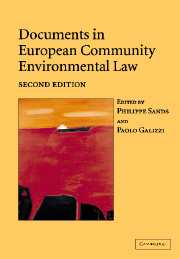Book contents
- Frontmatter
- Contents
- Preface
- PART I General principles of EC environmental law
- PART II European Community institutions and legislation
- PART III The relationship between environmental protection, financial assistance and free trade
- PART IV Procedural techniques of environmental protection
- PART V Protection of air quality
- PART VI Biodiversity and nature conservation
- PART VII Waste
- PART VIII Dangerous substances
- 39 Council Directive 92/3/Euratom of 3 February 1992 on the supervision and control of shipments of radioactive waste between Member States and into and out of the Community (OJ L 035 12.02.1992 p. 24)
- 40 Council Regulation (Euratom) No 1493/93 of 8 June 1993 on shipments of radioactive substances between Member States (OJ L 148 19.06.1993 p. 1)
- 41 Council Directive 96/82/EC of 9 December 1996 on the control of major-accident hazards involving dangerous substances (OJ L 010 14.01.1997 p. 13)
- 42 Directive 2001/18/EC of the European Parliament and of the Council of 12 March 2001 on the deliberate release into the environment of genetically modified organisms and repealing Council Directive 90/220/EEC (OJ L 106 17.04.2001 p. 1)
- PART IX Water quality
41 - Council Directive 96/82/EC of 9 December 1996 on the control of major-accident hazards involving dangerous substances (OJ L 010 14.01.1997 p. 13)
from PART VIII - Dangerous substances
Published online by Cambridge University Press: 06 January 2010
- Frontmatter
- Contents
- Preface
- PART I General principles of EC environmental law
- PART II European Community institutions and legislation
- PART III The relationship between environmental protection, financial assistance and free trade
- PART IV Procedural techniques of environmental protection
- PART V Protection of air quality
- PART VI Biodiversity and nature conservation
- PART VII Waste
- PART VIII Dangerous substances
- 39 Council Directive 92/3/Euratom of 3 February 1992 on the supervision and control of shipments of radioactive waste between Member States and into and out of the Community (OJ L 035 12.02.1992 p. 24)
- 40 Council Regulation (Euratom) No 1493/93 of 8 June 1993 on shipments of radioactive substances between Member States (OJ L 148 19.06.1993 p. 1)
- 41 Council Directive 96/82/EC of 9 December 1996 on the control of major-accident hazards involving dangerous substances (OJ L 010 14.01.1997 p. 13)
- 42 Directive 2001/18/EC of the European Parliament and of the Council of 12 March 2001 on the deliberate release into the environment of genetically modified organisms and repealing Council Directive 90/220/EEC (OJ L 106 17.04.2001 p. 1)
- PART IX Water quality
Summary
Editorial note
Directive 96/82 of 9 December 1996, as amended, is aimed at the prevention of major accidents involving hazardous substances and the limitation of their consequences (Article 1). The Directive applies to establishments where dangerous substances are present in the quantities it specifies (Article 2(1)). Exclusions to the application of the Directive are provided in Article 4. The operator of an establishment or installation subject to the provisions of the Directive is obliged to take all measures necessary to prevent major accidents and to limit their consequences for man or the environment and is required to prove to the competent authority that he has taken all the measures necessary (Article 5). The operator is to send to the competent authority the notifications specified under Article 6. Operators must establish a major-accident prevention policy and ensure its implementation (Article 7). Operators are to produce a safety report (Article 9) and establish emergency plans (Article 11). Member States are to ensure that the objectives of the Directive are taken into account in their land-use policies, through controlling the siting of new establishments, modifications to existing establishments and new developments such as transport links, locations frequented by the public and residential areas in the vicinity of existing establishments. In the long term, such policies should ensure that appropriate distances between hazardous establishments and residential areas are maintained (Article 12).
Information on safety measures and on the requisite behaviour in case of an accident shall be supplied regularly to all persons liable to be affected by a major accident (Article 13).
- Type
- Chapter
- Information
- Documents in European Community Environmental Law , pp. 761 - 786Publisher: Cambridge University PressPrint publication year: 2006
- 4
- Cited by



